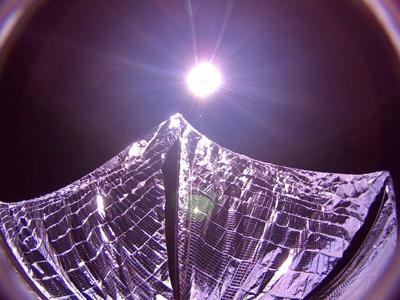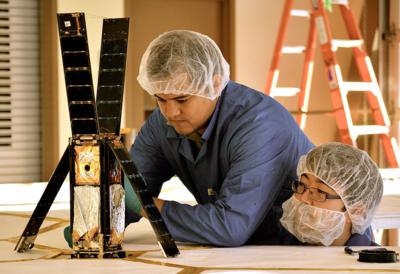Citizen-Funded Spacecraft Deploys Solar Sail, Milestone Step Toward 2016 Mission
A citizen-funded space mission launched by The Planetary Society has been declared a success. After 19 days in orbit, the CubeSat spacecraft deployed its Mylar solar sails in space. This marked a milestone for the mission to test LightSail’s critical functions in low-Earth orbit, a precursor to a second mission set for 2016.

“Our LightSail test mission was a success," said Planetary Society CEO Bill Nye. "We saw again that space is hard. It’s a test flight, and sure enough our little spacecraft tested us. I’ve got to congratulate our remarkable team. They solved some unexpected big problems up there with nothing but short radio signals sent from down here.
"This LightSail test taught us a lot, just as we hoped it would, and so we’re ready to do some real solar sailing with LightSail’s 2016 mission. Let me finish by reminding everyone that this mission and next year’s flight are funded entirely by our supporters and especially our members— people of Earth, who want to participate in space exploration. We’re changing the way humankind explores space. Today is a big day for The Society and for space explorers everywhere.”
A photograph taken by the spacecraft confirmed sail deployment. The photograph and an initial announcement were posted by Jason Davis, digital editor at The Planetary Society and embedded LightSail mission reporter.
“This week's flight was an ideal test in preparation for our primary mission in 2016. We were able to validate the function of all key spacecraft systems including solar sail deployment, and along the way the team was forced to deal with a number of anomalies and setbacks,” said Doug Stetson, LightSail project manager and founder and principal partner of the Space Science and Exploration Consulting Group. “We've learned a tremendous amount about our spacecraft and operations plan, and we're already preparing for what should be a spectacular flight late next year.”
David Spencer, professor of the practice at the School of Aerospace Engineering and director for the Center for Space Systems added, “This ambitious mission has been a challenge every step of the way. Throughout development and operations, our team has worked through problems, found solutions, and ultimately succeeded.”
The LightSail test spacecraft launched into orbit aboard a United Launch Alliance (ULA) Atlas V rocket from Cape Canaveral Air Force Station on May 20, 2015. The spacecraft was part of a secondary payload dubbed ULTRASat aboard the U.S. Air Force mission AFSPC-5.

Solar sailing works by using sunlight for propulsion. When solar photons strike LightSail's reflective Mylar sails, their momentum is transferred to the spacecraft, gradually accelerating it through space. While the push from photons is miniscule, it is continuous and unlimited. Solar sails can eventually reach greater speeds than those obtained from chemical rockets. LightSail is packaged into a small spacecraft called a CubeSat. CubeSats have made low-cost space missions a reality for universities and research groups.
“LightSail’s test mission success is an important stepping stone toward a new class of CubeSats employing solar sailing for propulsion, said Rex Ridenoure, CEO of Ecliptic. “We’re embarking on a new era for solar system exploration using very small satellites.”
The Planetary Society’s second LightSail spacecraft is scheduled to fly in 2016. This mission will build on the results of the test flight to conduct a full demonstration of solar sailing in Earth orbit. LightSail will be packaged inside a spacecraft called Prox-1 built by students at Georgia Tech. The spacecraft duo will be launched aboard a SpaceX Falcon Heavy rocket to an orbit of about 450 miles, and for about two weeks LightSail will serve as a rendezvous target for Prox-1 before LightSail conducts its primary mission.
The Planetary Society's solar sailing involvement was started by Society co-founder Louis Friedman more than a decade ago. Co-founder Carl Sagan championed solar sailing on a famous 1976 episode of The Tonight Show with Johnny Carson.
"This test mission has been a high-intensity, high-profile dress rehearsal," said Jennifer Vaughn, chief operating officer for The Planetary Society. "Through the ups and downs of our LightSail test flight, our members, backers, and supporters around the world have cheered us on. LightSail is a tangible symbol of citizen participation in space exploration. Behind the simple beauty of an image of a shiny sail in space lit by the Sun is the collective effort of tens of thousands of enthusiasts who got this project built, launched, and tested. The successful test flight belongs to all of us."
(Images provided by the Planetary Society. Top: "Selfie" taken by the cubesat. Bottom: Lightsail team members Alex Diaz (left) and Riki Munakata (right) prepare the spacecraft for a sail deployment test)
 Senator Pushes FAA to Accelerate Rocket Launch Licensing
Senator Pushes FAA to Accelerate Rocket Launch Licensing Classic Aero-TV: RJ Gritter - Part of Aviations Bright New Future
Classic Aero-TV: RJ Gritter - Part of Aviations Bright New Future Aero-FAQ: Dave Juwel's Aviation Marketing Stories -- ITBOA BNITBOB
Aero-FAQ: Dave Juwel's Aviation Marketing Stories -- ITBOA BNITBOB ANN's Daily Aero-Linx (10.27.24)
ANN's Daily Aero-Linx (10.27.24) ANN's Daily Aero-Term (10.27.24): Clearance Void If Not Off By (Time)
ANN's Daily Aero-Term (10.27.24): Clearance Void If Not Off By (Time)




